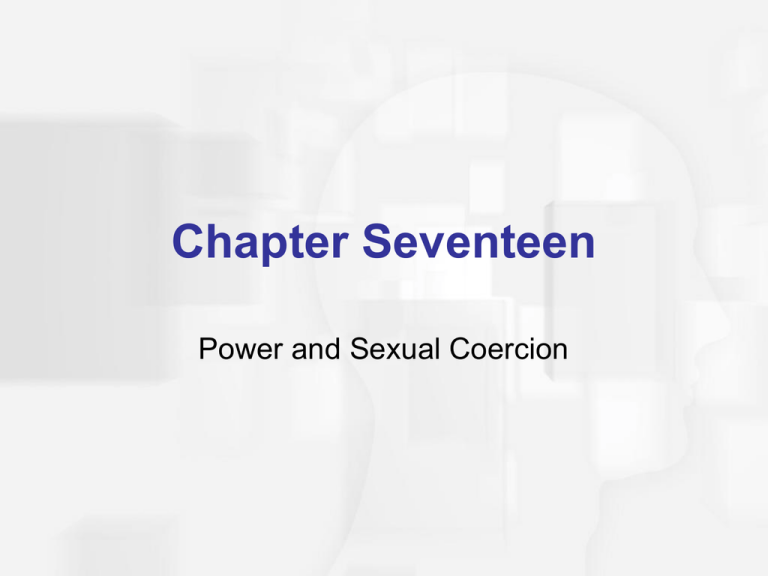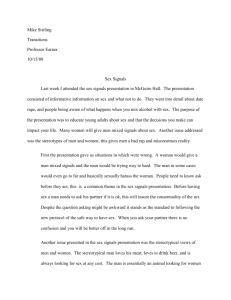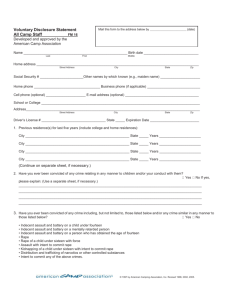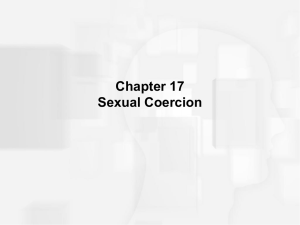
Chapter Seventeen
Power and Sexual Coercion
Agenda
Review Trends Associated with Rape and
Sexual Assault
Discuss Effects of Rape
Reporting, Avoiding, and Treating Rapists
Discuss Sexual Abuse of Children
Discuss Intimate Partner Violence
Discuss Sexual Harassment
Class Exercise: Part 1
I am going to read a series of statements. After I
read one, if you agree with it stand up. If you
disagree, remain in your seat.
Please note that everyone has a right to their own
opinion.
Date rape happens because of mixed messages.
Stranger rape is more traumatic than date rape.
Women say “no” when they really mean “yes”.
Women lie about rape.
A child who is sexually assaulted I an innocent
victim.
A woman who was drinking is partially to blame if
she is raped.
I know someone who was raped.
Class Exercise: Part 2
Discuss any of the statements that you feel
comfortable talking about.
Create a list of recommendations to help
lower the incidence of date rape.
Trends Associated with
Rape & Sexual Assault
Defining Rape and Sexual Assault
Incidence of Rape
Characteristics of Rapists
Theories about Rape
Gender Differences in Attitudes about Rape
Ethnic Differences in Attitudes about Rape
Rape in Different Cultures
Defining Rape and Sexual Assault
Rape is physically or psychologically forced
sexual intercourse
Sexual assault is the unwanted touching
(including penetration) of an intimate body
part for sexual arousal
Legal Definition of Rape and Sexual Assault
Every state has its own legal definitions of
rape and sexual assault
Commonly included in the definitions are lack
of consent, force or threat of force, & vaginal
penetration
Ejaculation is not necessary in most states
Those that have been sexually assaulted may
be referred to as victims or survivors
Incidence of Rape
One of the most underreported crimes in the
U.S.
Only Half of rapes are reported
Some do not report because they
don’t think it was rape
think they did something to cause it
are shamed and humiliated
fear they won’t be taken seriously
Continued …
Incidence of Rape
Estimated that 25% of U.S. women will be
raped in her adult lifetime
Rape is most common during the summer,
and at the lowest in December
Rape prevalence:
Industrialized nations: 21-25%
Non-industrialized nations: 43-90%
Prevalent on college campuses, primarily by
acquaintances & with verbal sexual coercion
Class Discussion
Why do you think that only half of rapes are
reported?
Discuss implications for each of your reasons.
What could be done to help support rape
victims so that they would report?
Characteristics of Rapists
Why men rape is mostly unanswered
60% of college men stated they would use
rape or force under the right conditions
(Ceniti & Malamuth,1984)
Continued …
Characteristics of Rapists
Between 15-30
Single
Antisocial personality patterns
High impulsivity & aggression levels
Negative early interpersonal experiences
Especially with their father
Sexist
Accept rape myths
Low self-esteem
Politically conservative
Past sexual abuse
Use violent & degrading pornography
Number of rapes/sexual assaults by relationship to offender, 2003. Source: U.S. Department of
Justice-Office of Justice Programs, 2003.
Theories about Rape
Rapist Psychopathology: A Disease Model
Victim Precipitation Theory: Blaming the
Victim
Feminist Theory: Keeping Women in Their
Place
Sociological Theory: Balance of Power
Rapist Psychopathology: A Disease
Model
Men rape due to alcohol intoxication, mental
illness, or uncontrollable sexual urges
Disease or alcohol leads men to rape
Research fails to support any physical
distinguishing characteristics of rapists
Victim Precipitation Theory: Blaming
the Victim
Victims make themselves vulnerable to rape
by their dress, behaviors, & where they go
Women are not engaging in risky behavior
prior to the majority of rapes
Men are more likely to believe this theory
than women
This line of thinking adds to victim’s guilt
Feminist Theory: Keeping Women in
Their Place
Rape and its threat is used by society to keep
women in a position subordinate to men’s
Sex-role stereotyping encourages rape
Men are strong & aggressive
Women are weak & passive
Sociological Theory: Balance of Power
Rape is an expression of power differentials
in society
When men feel they are losing power, they
need to overpower women with their symbol
of masculinity (penis) to reestablish a sense
of control over the world
Rape is a matter of power issues and sexual
issues
Gender Differences in Attitudes about
Rape
Men have less sensitive attitudes toward rape
& attribute more responsibility to the victim,
believe more rape myths & tend to read
friendly or neutral signals as an invitation to
sex
Females find rape more justified if a woman
was “leading a man on”
Men seem to have a decline in negative rape
attitudes over the four years in college
Rape in Different Cultures
The U.S. has the highest number of reported
rapes
Rape incidence varies by each culture’s
definition
In some cultures rape is accepted as a
legitimate form of punishment
In some cultures, rape is used as a form of
initiation
Rape on Campus
35 of 1000 college women are raped or have
an attempted rape each year
Most knew their attacker
Most college students do not feel comfortable
reporting the attacks or pressing charges
Most only tell a friend
8-16% of women & 2-7% of men have been
stalked, though the genders have different
definitions of stalking
Percentages of stalking behaviors on college campuses. Source: B. S. Fisher et al., 2000; Stalking
Resource Center, 2000.
Alcohol and Rape
Alcohol use is one of the strongest predictors
of acquaintance rape
Involved in half of all rape cases, either by the
victim, attacker, or both
Alcohol “sexualizes” the environment for men
Alcohol increases flirting & teasing for some
women
Alcohol increases risky sexual behavior in
women & men
Alcohol and Rape
43% of college women have regretted
intercourse while intoxicated
A drunk man who is accused of rape is seen
as less responsible due to the alcohol
A drunk woman who was raped is seen as
more responsible for her behavior
Discuss Double Standard about Alcohol and
Rape
Research suggests the following:
A drunk man who is accused of rape is
seen as less responsible due to the alcohol
A drunk woman who was raped is seen as
more responsible for her behavior
Why do you think this double standard exists?
What are the implications of this double
standard?
Effects of Rape
Rape Trauma Syndrome
Silent Rape Reaction
Rape of Partners and Other Special
Populations
How Partners React to Rape
Rape Trauma Syndrome (RTS)
RTS is a 2-stage response pattern of
physical, behavioral, psychological, and/or
sexual problems
Acute Phase (stage 1)
Long-term Reorganization (stage 2)
RTS: Acute Phase
Begins immediately and may last many
weeks
Fear of being alone, of strangers, & of the
place where the rape occurred
Anger, anxiety, confusion, shock, disbelief,
incoherence, guilt, humiliation, shame, selfblame
Wide mood fluctuations
Difficulties sleeping, nightmares
Most women tell someone, though half wait
years to do so
Continued …
RTS: Acute Phase
Most speak with friends or family, rather than police,
especially if younger
Depression may last up to 1 year, especially if prior
psychological problems, victimization, or a tendency
to self-blame; may lead to suicide
If she knew her attacker she experiences more
depression & guilt and loses some self-confidence
If the attacker was a stranger, she experiences more
anxiety, fear, & startle responses
Physical symptoms can include soreness, bruises,
vaginal itching, STI symptoms, eating problems, &
menstrual irregularities
RTS: Long-Term Reorganization
Long-term reorganization (stage 2) – can
persist for several years
Involves restoring order & regaining control
Sexual difficulties can persist for years and
counseling can help
Fear of sex
Desire & arousal disorders
Positive crisis intervention & supportive
others can decrease trauma symptoms
Silent Rape Reaction
Some victims never discuss the rape with
others, they repress & deny it until they feel
stronger emotionally
Will experience many of the same symptoms
of RTS
Those who take longer to tell another person
usually suffers a longer recovery period
Marital Rape
Marital rape is a crime in all states since 1993
Legal definitions vary by state
10-14% of married women are raped by their
husbands
Victims report symptoms similar to nonmarital victims
Often feel very betrayed & lose trust in others
Often there is little social support
Rape of Women with Disabilities
They are raped twice as often as women
without disabilities
May be more vulnerable because they are
less able to fight back and lack sexual
knowledge
Some may not realize their rights have been
violated
RTS is typically longer in this population
How Partners React to Rape
They often feel anger, frustration, feelings of
revenge, sense of loss, guilt, self-blame, &
jealousy
Rape places a lot of stress on a relationship
Couples are often reluctant to bring the topic
up, however, open communication is helpful
A stable & supportive partner can help a
victim recover more quickly
When Men are Rape Victims
Rape of Men by Women
Rape of Men by Men
Prison Rape
When Men are Rape Victims
5% of reported rapes are of male victims
Male rape is more underreported than female
rape
Men who are raped are often viewed more
negatively than women who have been raped
Men experience symptoms similar to women
& they can be long-lasting
Rape of Men by Women
Female rapists have used forced sex & verbal
coercion; most use psychological or
pressured contact
Of male college students, 34% reported
coercive sexual contact:
24% from women
4% from men
6% from both
20% experienced strong negative
reactions
Rape of Men by Men
1 out of 6 have unwanted sexual contact from
an adult by 16
Most common sexual assault is anal
penetration, then oral penetration
Getting the victim to ejaculate is important to
the attacker because it makes it less likely he
will report & it “proves” the victim “wanted it”
May lead to questioning of sexual orientation
and increase in sex to reaffirm his manhood
Prison Rape
Prison Rape Elimination Act (2003) – a
federal law with little tolerance for prison
sexual assault & required data collection
18% of inmates report sexual threat
8.5% report sexual assault
More typical with male inmates, though
female inmates may be penetrated with a
variety of objects
Prison Rape
Females are most often victimized by prison
staff
Assaulted inmates may experience RTS and
posttraumatic stress disorder
Inmates must continue to interact with their
assailants, which can increase the length of
RTS
They also lack access to rape crisis centers
or sympathy from employees
Reporting, Avoiding, and
Treating Rapists
Reporting a Rape
Avoidance Strategies
Treating the Rapist
Reporting a Rape
Estimates are that 1 in 7 rapes are reported
More likely to report if it was by a stranger,
there was violence, & if there was a weapon
Women are less likely to report if it doesn’t fit
the stereotypical rape scenario
Men are less likely to report if their masculine
identity is at risk
Those who report to the police have a better
adjustment
Process Associated with Reporting a Rape
Tell the Police
Press Charges
Court Procedures
Telling the Police
Campus police are often notified before local
police
Campus police can issue fines or dismissal
Local police can press charges
Alerts police of a crime
File formal reports needed for legal action
Some rape victims have negative
experiences with the police & often go
through an interrogation of the situation
Pressing Charges
Often the victim feels as if they are going
through a second rape because they are put
on trial more than the accused rapist
Court takes a lot of time, energy, & anxiety
Charges are pressed because of anger, to
protect others, or for justice
Not pressing charges may be due to fear,
wanting to forget, pitying the rapist
Civil lawsuits are easier to prove than criminal
Going to Court
A victim may wish to sit in on another rape
trial to prepare
The victim may also prepare for the possibility
of a not guilty verdict
Avoidance Strategies
Rape is the only violent crime we expect
someone to fight back
Proof of a struggle seems to produce
sympathy; some victims are frozen with fear
A person should try to escape as first strategy
If escape is not possible, try screaming,
dissuasive techniques, empathy, negotiation,
& stalling for time
Safest strategy is to make yourself a person
Treating the Rapist
Some therapies: shock treatment, support groups,
behavioral therapy, psychotherapy, & Depo-Provera
Results for these methods are inconclusive
First step in treatment is to accept responsibility for
their actions
Also try to decrease rape myths & increase
knowledge
Attitudes appear to change, but behavior changes
are not certain
High risk rapists (repeat offenders) don’t seem to go
through treatment with much success
Sexual Abuse of Children
Incidence
Victims of Sexual Abuse
How Children are Affected
Characteristics of Abusers
Treating Sexual Abuse
Preventing Child Sexual Abuse
Sexual Abuse of Children
Child sexual abuse – sexual behavior that
occurs between a child and much older
person
Behaviors are all illegal if the child is not old
enough or mature enough to consent
Child sexual abuse – with nonrelatives
Pedophilia – compulsive desire for a
particular age
Incest – with relatives
Continued …
Sexual Abuse of Children
Incest taboo is universal, due to the
vulnerable position of children in relation to
their parents; incest definitions vary by culture
Many types of incest
In the U.S., offenders are usually uncles and
male first cousins
Sibling incest & sex games also occur
Most incestual abusers are male
Incidence
Accurate statistics are difficult
Estimated 25% of girls and 10% of boys are
sexually abused as a child
False child abuse reports occur in less than
10% of cases
Victims of Sexual Abuse
Median age for boys & girls is 8 or 9
40% of abused boys & 21% of abused girls
are abused by strangers
29% of abused girls & 11% of abused boys
are abused by family members
Reports of male sexual abuse may be lower
than females because boys feel they must be
self-reliant, they should be able to handle it, &
there is a homosexuality stigma
Continued …
Victims of Sexual Abuse
Abuse reactions vary: fear, shame, self-blame
May seek help to protect younger siblings
Younger victims go to a relative for help
Older victims may run away or marry early
Incest with biological father creates the
longest delay in reporting
Incest with stepfathers or live-in partners
report the most quickly
How Children are Affected
Conflicting findings
Some report little traumatization
Some state there are long-lasting effects that
may lead to other psychological problems
Trauma is more severe if the abuse was for a
long time by a trusted person, penetration
occurred, there was aggression, and it was
not handled well in the family
Psychological and Emotional
Reactions
Sexual abuse can cause feelings of betrayal,
powerlessness, shame, guilt, fear, anger, selfblame, frustration, low self-esteem, &
intimacy problems
Psychological problems can include anxiety,
depression, nervousness, emotional
problems, dissociative disorder, posttraumatic
stress syndrome, and personality disorders
They are more likely to commit suicide
Long-Term Effects
Traumatic sexualization
Childhood: compulsive sex play or
masturbation; much sexual knowledge
Teens: promiscuity & frequent sex acts
Adulthood: sexual abuse of others
Eating disorders, drug/alcohol abuse,
prostitution
Learned sex is how they get attention from
adults; “bad” is incorporated into their self
Characteristics of Abusers
Poor social skills, lower IQs, unhappy family
life, lower self-esteem, less happiness in life
Most are heterosexual males with strict
religious codes
Often they deny responsibility & claim they
were in a trance
They are very good with manipulation &
blaming the victim for the abuse
The Development of a Sexual Abuser
The Development of a Sexual Abuser
3 prominent theories:
Learning – sexually abused as a child;
learned from others how to show affection to
children
Gender – males are not taught how to
express affection without sexuality; socialized
to be attracted to smaller mates
Biological – elevated levels of hormones (not
testosterone); neurological differences
Helping the Victims Heal
Most effective treatments combine cognitive
& behavioral psychotherapies that help the
victim understand & handle the trauma
Partners of victims can also benefit from
counseling
Treating Abusers
Treatment of sexual abusers is similar to that
of pedophiles
Main goal: decrease arousal to children
Other goals: better adult relations,
assertiveness training, empathy & respect,
sexual education
May use behavioral therapy, drugs, or
psychotherapy
High recidivism rates
Preventing Child Sexual Abuse
“Just say no” campaign – teaches children
how to say no
Increase the availability to sex education
Better funding & staffing of child welfare
agencies
Intimate Partner Violence
Defining Intimate Partner Violence and
Coercion
Preventing Intimate Partner Violence
Intimate Partner Violence
Also called domestic violence
29% of women & 22% of men experienced
intimate partner violence in their lifetime
Psychological symptoms: depression, anxiety,
low self-esteem, antisocial behavior, fear of
intimacy
Physical symptoms: headaches, back pain,
broken bones, stomach problems,
gynecological disorders
Defining Intimate Partner Violence and
Coercion
It is the use of threats, harassment, or
intimidation that may include physical,
emotional, and/or sexual abuse
Usually there is a pattern of abuse, not just
one incident
Many victims believe the problems are their
fault & that it is safer in the relationship
Finances, low self-esteem, fear, & isolation
can make it difficult for a woman to leave
Preventing Intimate Partner Violence
Related factors: history of partner violence in
the offender’s family, excessive alcohol use
Educational programs & safe housing can
help victims
Sexual Harassment
Incidence and Reporting of
Harassment
Preventing Sexual Harassment
Sexual Harassment
Sexual pressure imposed on someone who is
not in a position to refuse it
Broad term that includes jokes, unwanted
sexual advances, a “friendly” pat, “accidental”
touches
Many people are confused about what it all
entails
Can create psychological side effects similar
to rape & sexual assault; also, suicide
Incidence and Reporting of
Harassment
25-30% of college students report
experiencing sexual harassment
Typically sexist jokes, comments, or touching
The majority do not report it, though it is
prohibited by federal law
Women are 9 times more likely to quit a job, 5
times more likely to transfer, & 3 times more
likely to lose their job due to sexual
harassment
Continued …
Incidence and Reporting of
Harassment
Sexual harassment can happen to men, as
well as women
Sexual harassment creates a hostile &
intimidating environment
Assertiveness (tell others or the offender) is
the most effective strategy to deal with it
Gender differences exist in interpretation
Men may view something as flattering that
women view as threatening
Preventing Sexual Harassment
First step – acknowledge the problem
Organizations and institutions should have
established and strong policies to deal with
sexual harassment
Education to help men adjust is necessary as
more women are entering the workforce






